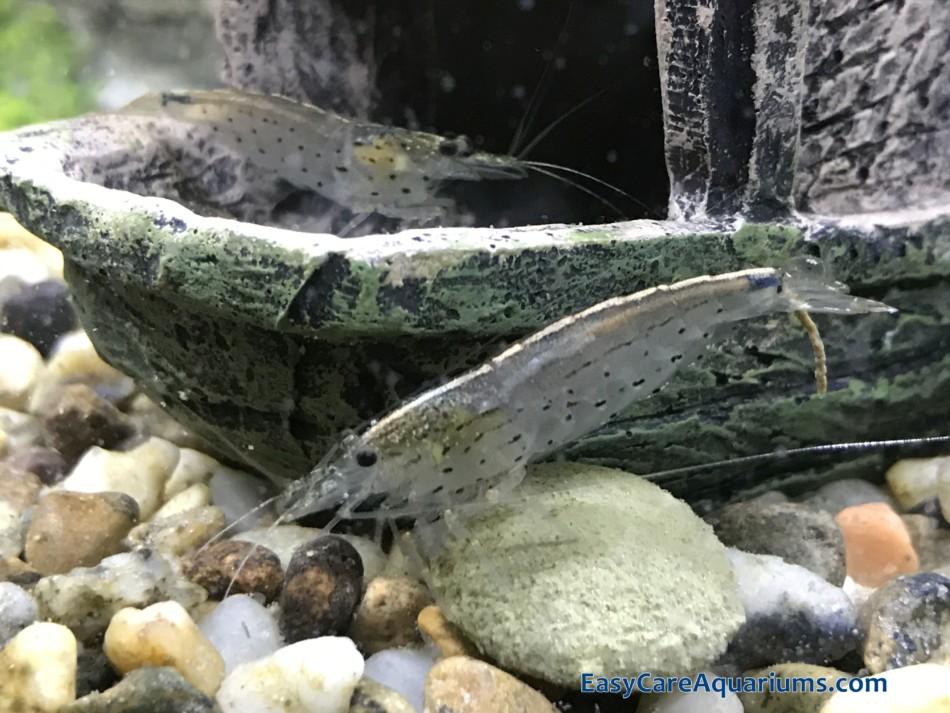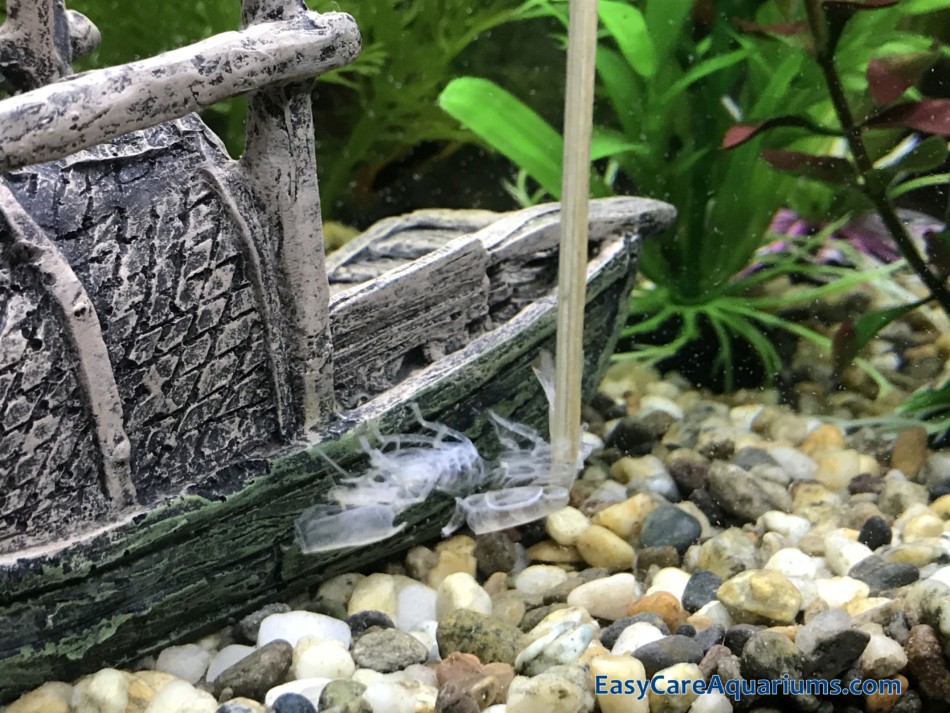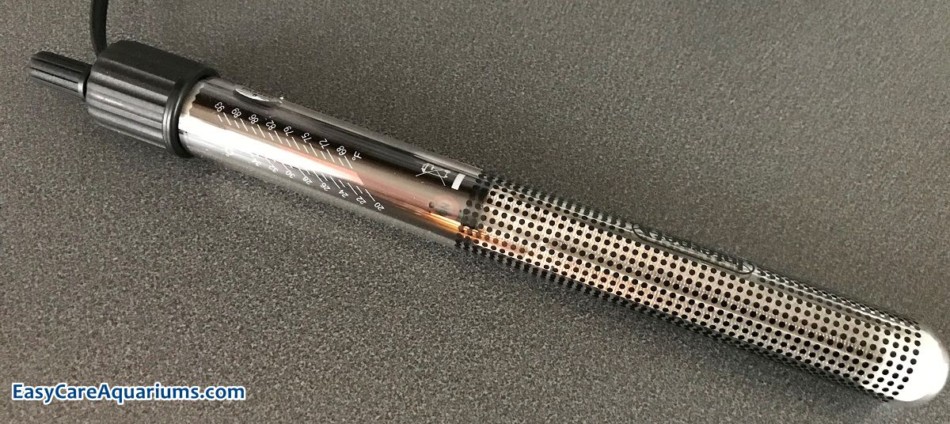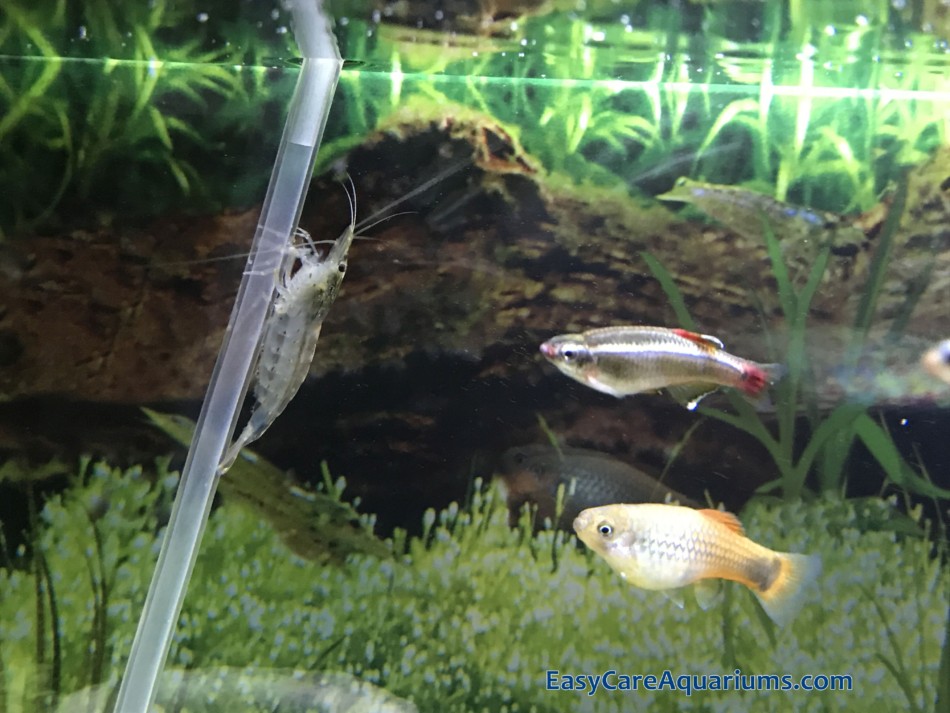This article may contain some affiliate links to products. The links provide me a small percentage of commission but do not cost you anything extra to use. (See full disclosure statement here ).
).
Amano Shrimp (Caridina Multidentata) were introduced into the aquarium hobby in the 1980’s by Takashi Amano. He discovered that this particular shrimp had a huge appetite for algae. Which has made the Amano Shrimp a valuable addition to aquariums to this day.
Despite their lack of colouring, the Amano is still a nice looking shrimp. It can be difficult to describe their colouring. But I guess you’d say they were mainly translucent, with hints of brown or grey, with brown dots and dashes along their sides.
Fully grown at around 2 inches (5.08 cm), Amano Shrimp are easy to see, despite their pale colouring. And it’s fun to watch them doing their run/swim thing as they explore the tank looking for food.
The average lifespan of an Amano shrimp is 2-3 years. And during this time they become great members of your clean-up crew. After all, searching for, and eating algae, really is their thing.
Add to all this their peaceful nature, and you can see why the Amano is so popular in the freshwater aquarium hobby.
So, now you’ve got an overview of the Amano Shrimp.
But what about the more specific questions that you’re bound to ask if you want to keep Amano Shrimp in your aquarium?
Below the video is a list of frequently asked questions about Amano Shrimp. Just click on the links to take you straight to the answers. Or read as you scroll through the post to get the the bigger picture.
If you prefer to watch a video then most of the main points are covered in my YouTube video (Just click below to watch here).
- What Do Amano Shrimp Eat?
- Why Do Amano Shrimp Moult?
- What Tank Water Conditions Do Amano Shrimp Need?
- Do Amano Shrimp Need A Heater?
- Do Amano Shrimp Need A Light?
- Do Amano Shrimp Need Plants?
- Which Fish Are Good Tank Mates For Amano Shrimp?
- Is My Amano Shrimp Male Or Female?
- How do Amano Shrimp Breed?
Let’s get started on your in-depth care guide to keeping Amano Shrimp
Tip: Amano Shrimp are also known by other names such as: Caridina Japonica, Yamato Shrimp and Algae Eating Shrimp. But it’s still the same shrimp.
1. What Do Amano Shrimp Eat?
Amano Shrimp are definitely not picky eaters. Because they’re omnivorous they will eat both vegetation and meaty protein.
Here’s some of the foods you can offer to your Amano Shrimp
- Algae Wafers
- Flake Food
- Sinking Pellets
- Vegetables
- Protein e.g. Blood Worms, Brine Shrimp
How To Feed Algae Wafers To Your Amano Shrimp
The Amano Shrimp is a big eater of the algae that grows naturally in an aquarium. Soft algae of all kinds is a tasty snack as far as the Amano is concerned. It’s even reputed to be one of the few aquarium inhabitants that will eat Black Beard algae.
But if your tank tends to only get minimal algae growth you’re probably going to worry that your Amano Shrimp are not getting enough.
The easiest way to top up their algae supply, without messing up your tank, is to feed them algae wafers.
Algae wafers sink to the bottom of the tank so it’s best to try and drop them in an area that’s goings to be easy for you to remove the leftovers later. Although don’t be surprised if your shrimp have dragged the wafer into a cosy corner to keep it it all for themselves!
The same goes for any sinking pellets that you give to your Amano Shrimp. They probably won’t stay where you put them but it’s important to remove any leftovers after a few hours.
How To Feed Flake Food To Your Amano Shrimp
Nothing could be easier than feeding flake food to your Amano Shrimp, right?
It’s definitely simple enough to drop some food flakes into the tank when it comes to feeding time. But there are a couple of things to consider when it comes to flake foods.
The first thing is to make sure you buy a good quality flake food that contains all the nutrition that your shrimp will need to stay healthy.
The second thing is not to overdo the feeding. While Amano Shrimp are great at clearing up leftover flake food, if you overfeed them you’ll end up with food that’s trapped in the substrate (e.g. gravel). And, over time, it’s going to rot and pollute the water.
Unless the excess flakes are still floating on the top of the water the only way to remove them is by using a gravel vacuum. So if you want to avoid extra tank maintenance don’t add any more flakes than your shrimp can eat within a few hours.

How To Feed Vegetables To Your Amano Shrimp
Amano Shrimp love their vegetables. Here’s a few that are favourites with my Amanos.
- Broccoli
- Cauliflower
- Spinach
- Courgette (Zucchini)
You can also feed them kale, cucumber, squash and peas. They’re all good veggies for Amano Shrimp and you’re likely to find that they will enjoy them all. And you can experiment with other types of veggies too.
Tip: You need to soften the vegetables first by simmering/microwaving until the veg is soft enough for the shrimp to eat. Let the vegetables cool down to room temperature before putting them into the tank.
My female Amano Shrimp has a passion for cauliflower. Whenever I put it into the tank she drags it away and tries to keep it all for herself. The other shrimp and fish are not fooled though. They soon sniff it out and join her in the meal.
Unfortunately it’s left to me to track down the leftovers at the end of the day. Which is not always an easy task!
Will Amano Shrimp Eat My Aquarium Plants?
Even though the Amano loves to eat green stuff it rarely eats live aquarium plants. That’s not to say it won’t ever eat them if it’s hungry enough. Or maybe if a particular shrimp has taken a fancy to one of the plants in your aquarium.
But It’s not something they’re generally known for.
They will eat leaves that are decaying though. Especially if the leaf has fallen to the bottom of the tank.
Amanos will also eat algae off the plants. Which can make it look like they’re eating the plant itself even though they’re just cleaning up for you.
So, in general, your aquarium plants should be safe from being eaten by your Amano Shrimp
How To Feed Protein Foods To Your Amano Shrimp
Despite their love of algae and vegetables the Amano Shrimp needs some protein in their diet too.
A good quality flake or pellet food will contain both meaty protein, veg and additional nutrients to keep your shrimp healthy. But a little extra protein is always welcomed by your Amano Shrimp.
Bloodworms and Brine Shrimp are popular ways to feed Amano Shrimp a little extra protein. They will eat other types of protein packed organisms too. So you could experiment a little if you want to.
You can usually buy protein foods like Bloodworms and Brine Shrimp either fresh, frozen or dried.
I prefer to buy mine dried. The reason for this is that, despite it’s big appetite, the Amano only has a tiny mouth. Dried Bloodworms for example, are so much easier to crush down to size for my shrimp. I admit that I’m a little squeamish too. I really don’t fancy having to chop live, or even defrosted Bloodworms, up before I put them into the tank.
Once I’ve crushed the dried bloodworms down I soak them in a little tank water for a while. Usually for about 10 minutes. Rehydrating them means they will start sinking more quickly rather than floating on the top for ages. Then I just tip them into the tank.
It’s up to you how you want to do it. But remember not to overfeed your shrimp or you’ll have a difficult job removing any excess from the aquarium.
When it comes to meaty snacks Amano Shrimp will also eat any fish, snails, and even other shrimp, that die in the tank. It might sound a bit gruesome but it’s just nature.
It’s still best to remove any dead tankmates as soon as you spot them though. If you leave it too long and the deceased starts to decay you can end up with a big ammonia spike in the tank water. Which will put all of the tank community at risk.
Tip: If your Amano Shrimp are too well fed with other foods they will eat far less algae. So if you want to encourage them to keep your aquarium clean be sparing with the rest of the food.

2. Why Do Amano Shrimp Moult?
The Amano Shrimp is an invertebrate. Which means that it doesn’t have an internal skeleton like we do. The Amano’s ‘skeleton’ is on the outside of its body and is called an exoskeleton. Which basically means it’s an outside, instead of an inside, skeleton.
As the Amano Shrimp grows it gets too big for its exoskeleton. The way it gets around this problem is to shed the one that’s now too small, and it grows a new better fitting one.
Amano Shrimp moult on a regular basis while they grow into adulthood. Usually about every 4-6 weeks or so, until they reach their maximum size of around 2 inches (5.08 cm). After that the moulting happens less often. But the Amano Shrimp will continue to replace its exoskeleton throughout its life.
Once the Amano has moulted it’s new exoskeleton is soft. Which makes the shrimp feel more vulnerable from attack. So the Amano Shrimp will hide away for between 1-3 days until it’s new outer shell has hardened and it feels safe to venture out again.
So don’t worry too much if you can’t see one of your Amano Shrimp for a while after you’ve found a moult in the aquarium. It will be back out and about when it’s ready to.
What Does An Amano Shrimp Moult Look Like?
The first time you see a moult from one of your Amano Shrimp it can be quite unnerving. Because the moult is the exact replica of the shrimp itself, antennae and all, you’d be forgiven for thinking that one of your Amanos has died.
The main difference between a moult and a dead Amano is the colour. Moults are an opaque white colour and look like an empty ‘shell’. A dead Amano Shrimp tends to be orange in colour and looks more solid than a moult does.
After your Amanos have moulted a couple of times you’ll be able to tell the difference at a glance.
Should I Remove An Amano Shrimp Moult From The Tank?
The thing about shrimp moults is that they are full of good stuff like minerals. And nature being what it is it doesn’t like to waste anything.
So you’re likely to find that the other tank inhabitants will nibble on the moult to get the benefit of this. Fish, shrimp and even snails are partial to snacking on a moult. It’s good for them and makes a tasty snack.
This means that you can leave an Amano Shrimp moult in the tank for a while. Say a day or so. You might find that it’s all been eaten by then anyway. But if not, remove what’s left it so that it doesn’t decay and spoil the tank water.
Tip: Amano Shrimp are sensitive to Copper. In fact, it’s deadly to them. So avoid any food or aquarium medications that contain Copper.
3. What Tank Water Conditions Do Amano Shrimp Need?
Amano Shrimp prefer aquarium water that’s a little on the hard side. The reason for this is that harder water contains more calcium than softer water. Calcium is important for the healthy growth, and regrowth, of the Amanos exoskeleton. Which they regularly replace over their entire lifespan.
You can measure the hardness of your water by using an aquarium water testing kit.
I’ve got the 6 in1 ‘dip-strip’ type testing kit from the Tetra range. (Link will take you to Amazon). There are lots of other types of testing kits available to buy in store and online. But I chose this one because of it’s good reputation, and more importantly for me, because its easy to use.
How Can I Increase The Hardness Of My Aquarium Water?
If you live in a soft water area there are ways that you can increase the hardness of your aquarium water.
Here’s a few things that fish keepers use to increase their tank water hardness
- Crushed Coral
- Cuttlebones
- Egg Shells
- Calcium Rich Rocks (eg Limestones)
- Liquid Aquatic Water Hardening Additives
As you can see there are different ways to increase the hardness of your aquarium water.
Tip: Before adding any type of water hardener to your tank get some expert advice from your Pet Store, Aquatic Dealer, or from a reliable online source. And don’t forget to take the needs of your Amano Shrimp’s tankmates into account too.
Another way to make sure that your Amanos have enough calcium to moult successfully is to provide the calcium through their diet.
Feeding them good quality shrimp foods, and adding extra calcium rich vegetables to the menu, can make all the difference to the Amanos moulting process.
Although diet won’t increase the hardness of your tank water, calcium rich veggies like broccoli, spinach and kale are good for your shrimp.
If you think that your water supply is the problem get some expert advice on how to improve its quality.
Water Changes And Amano Shrimp
The most important thing to remember when it comes to water conditions in an Amano Shrimp tank is stability. Like most shrimp the Amano struggles to cope with sudden changes in water quality. So keeping things on an even keel is important, even when your Amano Shrimp are part of a community tank.
You can keep the tank water stable by having an efficient filter, carrying out regular water changes and regular tank maintenance.
Regular tank maintenance also helps to keep the levels of Nitrites and Nitrates in check. Both of which, but particularly the Nitrites, can be deadly to shrimp (fish and snails) if they’re allowed to become too high.
When it comes to water changes it’s best not to overdo it. Large water changes can drastically, and suddenly, alter the water parameters. Amano Shrimp, and other types of shrimp, don’t do well with that amount of disruption to water quality.
While you need to carry out partial water changes weekly, and general tank maintenance monthly, you also need to be careful not to upset the balance of your aquarium too much each time.
Stability in water conditions, and in the general tank conditions, are key to successfully keeping Amano Shrimp.

4. Do Amano Shrimp Need A Heater?
The ideal temperature for Amano Shrimp is between 18-27 Degrees Celsius (64.4-80.6 Degrees Fahrenheit). However, they can tolerate temperatures a little lower and also a little higher than this. And because Amano Shrimp cope well in a wide range of temperatures they don’t usually need a heated tank.
But this isn’t always the case.
Here’s a few reasons why you might need to add a heater to your Amano Shrimp tank
- Your Climate – If your home heating is off for most of the day due to work and other daily commitments, and you live in a cold climate, you may have to heat your Amano tank to at least 18 Degrees Celsius (64.4 Degrees Fahrenheit).
- Tank Housing – If you house your Amano Shrimp Tank in a shed, outhouse, or other unheated building, you might have to install a tank heater during the colder months of the year.
- Tankmates – If your Amanos live in a community tank with other kinds of shrimp, fish and/or snails you have to take their tankmates needs into account too. You’ll need to find a happy medium in temperature to keep everyone in your aquarium fit and healthy.
- Plants – Just like the Amano’s tankmates plants need to be taken into consideration when it comes to temperature. You may need a heater in the tank to keep up a temperature that suits the plants as well as all your other tank inhabitants.
So you may need a heater. But then again you may not. It’s a case of getting the balance right. And how you do that will depend on your own circumstances.
Tip: Amano Shrimp are great escape artists and are known to climb out of the tank. While the Amano can survive out of water for a short while it won’t be able to get back into the tank. To avoid losing any of your shrimp this way make sure that you have a close fitting lid on your aquarium.
5. Do Amano Shrimp Need A Light?
Amano Shrimp need periods of both light and dark. Which makes having an aquarium light important. By using a light in your tank you will be able to mimic the natural lighting effects of day and night. However, you will need to provide shaded areas in your tank during your lighting period. And there’s a couple of good reasons for this.
Firstly, providing darker areas in your aquarium, even during the day, allows your shrimp to retreat to a dimly lit spot. Having shaded places to hide, or rest in, helps to reduce stress in your Amanos.
Secondly, Amano Shrimp really appreciate shady places after they have moulted and are feeling at their most vulnerable. So you might not see a shrimp that’s just moulted for a while. But it’s important for them to have a little seclusion. Your Amano will be back out in the tank with the others as soon as it feels that its outer shell is tough enough.
How To Create Shaded Areas In Your Amano Shrimp Tank
Creating shaded areas in your Amano’s tank isn’t complicated. In fact there’s a couple of simple things you can do without any trouble at all.
Plants
By having a densely planted area in your aquarium you instantly create a darker space even when your tank light is on. Whether you go for live or artificial plants is entirely up to you. But either way, your Amanos will be able to find a dimly lit place when they need to.
Tank Decorations/Ornaments
How you decorate your tank is a personal thing. You might not want shop bought tank ornaments in your aquarium if you’re going for a more natural look. But there are aquarium-safe decorations that provide Amano Shrimp with an area away from the light. And some of them can look quite natural.
For example, you can use aquarium pebbles/stones piled up to create a sheltered cave area for your shrimp. Or buy a ‘half-coconut’ dome that has a small opening at the base so that your Amanos can go inside when they want to. You can get real coconut shell ones or artificial ones that look good too. They’ll both do the same job as far as your Amano Shrimp are concerned.
My Amano Shrimp are in a community tank which has live plants, an artificial plant, and also some tank decorations. Their favourite hiding places are the sunken boat and the tower ornaments. And sometimes, depending on their mood, they use the space behind the filter casing. But, whichever one they choose, they have a dimly lit and secluded place to moult or rest in.
A General Point In Favour Of Lighting Your Amano Shrimp Tank
Having a tank light in your Amano tank makes it easier to check on how your Amanos are doing. And it also makes it easier to enjoy watching them as they explore the tank looking for food. After all, there’s no point in keeping an aquarium if you never see anything other than the plants and rocks.
Tip: An easy way to create a shaded area in your tank is to place external lighting to one side. If that’s not possible, because your light is built into the hood, you can cover a side portion of the bulb with black electrical tape. This will reduce the lighting on that side of the tank.

6. Do Amano Shrimp Need Plants?
Amano Shrimp definitely benefit from having a planted tank. Live plants in particular are great for the Amano. Live plants provide shelter for resting and de-stressing in. And also spaces to hide in after moulting while the Amano’s exoskeleton hardens. The plants also naturally generate the growth of small aquatic organisms that provide a free source of protein for the Amano Shrimp.
Since I added Java Moss to the community aquarium that my Amano Shrimp live in I’ve noticed tiny Copepods in the tank. Both the Amanos and the fish enjoy feasting on them.
Which is good for the shrimp and fish and also helps to keep the population of Copepods down. And because Copepods are considered an aid in keeping your aquarium clean it’s good news all round.
Tip: If your tank is becoming overrun with microorganisms it likely to be down to overfeeding your tank inhabitants. So cutting back on the amount of food that you feed each time will help to reset the balance. Less leftover food means less for the microorganisms to feed off. Which naturally slows down their reproduction rate.
Plants also provide grazing areas for Amanos. Whether it’s grazing for microorganisms, algae or leftover food, plants make life a little more interesting for your shrimp.
They make your tank look good too.
Here’s a few easy care aquariums plants that you can use in an Amano Shrimp tank
- Java Moss
- Java Fern
- Dwarf Rotala
- Dwarf Anubias/Anubias Nana
- Cryptocorynes (various)
- Water Lettuce (floating plant)
Whatever aquarium plant you choose make sure that you know what care the plant will need from you before heading to the checkout.
If you prefer artificial plants to live ones you will still be providing sheltered places for your Amano Shrimp. You won’t get the same, if any, growth of microorganisms though. But as long as you feed your shrimp with good quality foods they will do well.
If you do opt for artificial plants for your aquarium choose ones that are softer and without any sharp edges. That way you will reduce the risk of injury to your shrimp, and their tankmates, as they go about their daily business in the aquarium.
7. Which Fish Make Good Tankmates For Amano Shrimp?
Because the Amano Shrimp is a peaceful, non-aggressive shrimp, it needs tankmates that are like minded. And also ones that are not big enough to eat them either!
Here’s some of the fish that make good tankmates for Amano Shrimp – click the links to check out some of my articles giving more information about these potential tankmates.
- Platy

- White Cloud Mountain Minnow

- Guppy
- Endlers

- Molly
- Dwarf Corydoras Catfish
- Otocinclus Catfish
- Bristlenose Pleco
There other fish that will live quite happily with your Amano Shrimp. So if you don’t fancy any of the fish on my list have a word with your Pet Store, or Aquatic Dealer, for some other suggestions.
Another important thing to bear in mind is that each fish keepers experience can be different. So what works for one person might not go so well for you. But if you don’t try you’ll never know. Just get yourself some good advice first.
Amano Shrimp are also happy to share their aquarium with non-aggressive snails like the Nerite. They’re also happy to live with other non-aggressive shrimp too, such as the Cherry or Wood/Bamboo shrimp.
So it’s not difficult to set up a community tank that will suit your Amanos.

Tip: Amano Shrimp prefer to live in groups of 6 or more. Having a small group of Amanos helps to dilute dominant behaviour. It’s common for the largest shrimp to take and hoard all the food for itself. But if you have a few Amano Shrimp together it makes this sort of behaviour less likely.
8. Is My Amano Shrimp Male Or Female?
Telling the difference between a male and female Amano Shrimp is not as difficult as it can be with some other shrimp.
Here’s a general guide for sexing Amano Shrimp
Male Amano Shrimp – The male is usually smaller than the female but it can be difficult to see this unless they’re side by side. So the best way to tell is to look at the lowest row of the dotted line that’s on the shrimps exoskeleton. This lowest row on a male is a line of evenly spaced dots. The males stomach is also flatter and straighter than the females.
Female Amano Shrimp – The female is bigger and chunkier than the male. The lowest row of markings is a broken line of dashes or elongated dots. The females stomach is larger and rounder than the males because this is where she carries her eggs.
I have both male and female Amano Shrimp (as far as I can tell). But unfortunately they wouldn’t cooperate for a photo shoot so that I could show you the difference between the two.
There are photos of both male and female Amanos online though. So if you’re struggling to sex your Amanos it’s worth taking a look at some images to help you out.

9. How Do Amano Shrimp Breed?
Although Amano Shrimp will sometimes breed in a freshwater tank it’s highly unlikely to be successful. Even if the eggs hatch out the Amano larvae won’t survive for more than 48 hours in a freshwater environment. Amano larvae need brackish (slightly salty) water to thrive in until they’re ready to move into freshwater and grow to adulthood.
Like a lot of other shrimp the breeding process generally starts after the female has moulted. She then hides herself away and releases pheromones into the water to attract the males. The males seek her out and the one that finds her will mate with her.
The problem for fish keepers and shrimp keepers alike, is that the Amano larvae need salty water to begin with. So unless you have a brackish water tank to move the newly hatched larvae to, and a good knowledge of the process, you’re not going to find breeding Amano Shrimp viable.
However, it is possible to breed Amano Shrimp successfully if you have the right equipment, the right information and a fair amount of time and patience.

